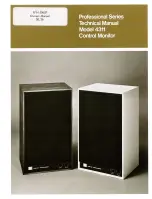
Testing and alignment:
●
Since the rig does not have it's own internal power fuse, it is a good idea to use a power cord with an in line fuse or a current
limited power supply which can be set to 1 amp. If there happens to be a problem during testing, this will prevent damage to the
board and/or your power supply.
The first test is to check operation of the VFO and BFO:
This can be done with an external frequency counter, the digital dial or a general coverage shortwave receiver with external antenna jack
and BFO. If none of these are available, you will have to assume the frequency range is about right and check it later with an 80 meter ham
band receiver.
1.
Apply power to the board and turn on.
2.
If you have the Digital Dial installed, it should come on.
3.
Connect the Digital Dial input or a frequency counter to the test point “VFO”
4.
The frequency should be between 5.00 and 5.35 MHz depending on the setting of the tuning capacitor.
5.
With both the tuning capacitor and RIT control tuned fully counter clockwise, the VFO frequency should be slightly
above 5.000 MHz. 5.000 MHz corresponds to an operating frequency of 4.00 MHz. (9 – 5)
6.
The VFO frequency is “tweaked” by adjusting the spacing of the turns on the VFO coil, T5. Moving turns closer together
will lower the frequency. If the frequency is already too low, you will have to remove a turn from the coil to increase the
frequency.
7.
Move the frequency counter to the “BFO” test point and verify a frequency about 9.000 MHz. With the counter at this test
point, now is a good time to set the BFO trimmer, CT1. Using a small slotted screwdriver, adjust the trimmer for a BFO
frequency to about 9.003,000 MHz. NOTE: a frequency counter connected to the BFO test pad can load down the
oscillator so you may not be able to reach 9.003,000 MHz. The BFO frequency can also be found on pin 7 of U1. This is
a buffered signal, so it will not be affected by the counter probe capacitance loading.
●
You can now install all the IC's into the sockets. Pay attention to the orientation, as they don't all face the same direction. The dot
or notch on the part indicates the Pin 1 end and corresponds to the notch in the socket.
1.
Connect an antenna and speaker or headphones to rear panel jacks
2.
Connect power cable and turn on.
3.
Turn up the volume and you should start to hear band noise or signals when you tune around. (depends on time of day)
4.
If needed, tweak the BFO trimmer for the most natural sounding voice or band noise. You could also connect the audio
output of the rig to your PC running a PSK program like Digipan. The waterfall will give you a visual indication of the
bandwidth of the receiver audio.
5.
Peak the receiver input transformer, T3. It should peak with bewteen a ½ to full clockwise turn of the slug.
●
If you are using the Digital Dial, it can now be set up for direct reading of the operating frequency
1.
Connect the frequency input wire to the “BFO” pad on the main board.
2.
Tap a short across the “OFFSET SW” pads on the back of the DDial board. The display will change to read “Lo --”
3.
Click the front panel switch three times to select the “Lo C” mode.
4.
Click and hold closed the front panel switch until the display changes back to numeric characters (should be all zeros).
5.
Move the frequency input wire from the “BFO” pad to the “VFO” pad.
6.
The dial is now showing the operating frequency.
Transmitter testing:
●
Set PA BIAS and MOD controls (VR1 and VR2) to full counter clockwise. They come set from the factory at full clockwise.
●
Turn rig on.
●
Ground PTT input using microphone, straight key or jumper. TIP is PTT if wired as shown in diagram.
●
Check for 5 volts at Anode (banded) end of D4 and D5. (reference wiring diagram for location) This is very important!
13
Manual revised 20160229
Summary of Contents for The Survivor
Page 18: ...18 Manual revised 20160229...





































